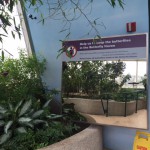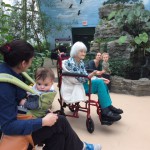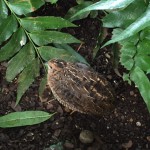By Chencheng Zhao
Hundreds of butterflies clad in wings of every shade glided across the serene pools and landed on flowers and tropical trees while Orange-breasted Waxbills and Green Honeycreepers watched them. This isn’t a tropical rain forest but the Butterfly Haven at the Peggy Notebaert Nature Museum where visitors pack the haven for the release of butterflies.
Walking through the haven set visitors free from the hustle and bustle of the city.
Brian Israel of Chicago said he accompanies his mom to the haven every year. She loves animals, and he wants to bring her to them as often as possible.
“They’re so lovely. I wish they could stop,” said Vi, Israel’s mom, reaching out her hand from the wheelchair.
It is the first time Chicago composer Zachary Gordon visited the haven. Gordon relaxed, calmed by the surroundings of nature. “When in the city, you don’t see a lot of nature. You just want to get out of the house and do something different.” Gordon said.
Marketing exdecutive Leila Goldberg revisited the haven with her six-month-old baby Stephen. “Look at this beautiful little thing!” Goldberg said, taking the boy’s hand and pointing it at a butterfly basking on a flower. Goldberg said the haven is a good place to explore, particularly good for the baby who is starting to build his visual curiosity and perception.
“This is a very self-contained space,” said Robert Wells, of visitor services. “And the cycle of nature takes care of itself.”
Plants refresh the air and lock in moisture. The flying birds feed on fruit, nectar and seeds while the ground dwelling ones feed on ants, roaches and, yes, dead butterflies.
“They are our groundkeepers and pest control,” Wells said, looking at a Chinese quail strolling under the bush, looking for butterfly bodies.
Wells said the 2,700 square-foot greenhouse is equipped with watering and heating system that automatically adjusts the environment around the clock.
“Did you hear the clunk? It is the misters turned on, showering water vapor.” Wells said, pointing to the pipes and sprinklers on the ceiling.
Because all the birds and butterflies are from tropical areas, they like things warm and humid —80 to 85 degrees Fahrenheit with 20 to 30 percent moisture.
“There is no native species here right now,” said Allen Lawrance, living invertebrate specialist at Peggy Notebaert. He introduced some of about 45-50 butterflies species present, all coming from tropical area — Rice Paper, Scarlet Mormon and Clipper from Malaysia; Great Egg Fly from Australia; and Tawny Owl, Tiger Longwing and Red Cracker from Costa Rica.
Lawrance said butterflies can be seen in the tropical area all the year round. But they are warm weather when flying in Chicago. “No butterfly can endure a Chicago winter in its active stage,” Lawrance explained. Most survive by hibernating. Each hibernating species spends the winter during a specific stage of its life cycle —either egg, larva pupa or adult. The Monarch —unique among North American butterflies —survives by migrating thousands of miles south. Others, such as the Painted Ladies, don’t survive at all. They die off each winter, replaced the following spring by new Painted Ladies that migrate in from farther south.
However, the museum has its own migration pattern for bringing butterflies north.
Wells said instead of breeding butterflies, the museum purchase chrysalises from butterfly farms around the world. Suppliers raise the butterflies from egg to chrysalises, then pack them in boxes and ship them to the museum overnight. Each week, the haven receives several shipments.
Upon arrival, staff unpack the chrysalises and hang them up in the lab. Wells said it takes about two to three weeks for the butterflies to emerge.
Butterflies are released into the haven at 2 p.m. every day, Lawrance said.
At the exit stands a big mirror, with the sign: “Please leave all butterflies inside of the Butterfly Haven.” Visitors check themselves in the mirror when they leave the haven, gently brushing off any hitchhikers. Wells explained the haven holds tight security for these immigrants, according to U.S. department of agriculture’s limitation on exotic animals.
Let nature take its course here. These exotic beauties belong to the haven.









